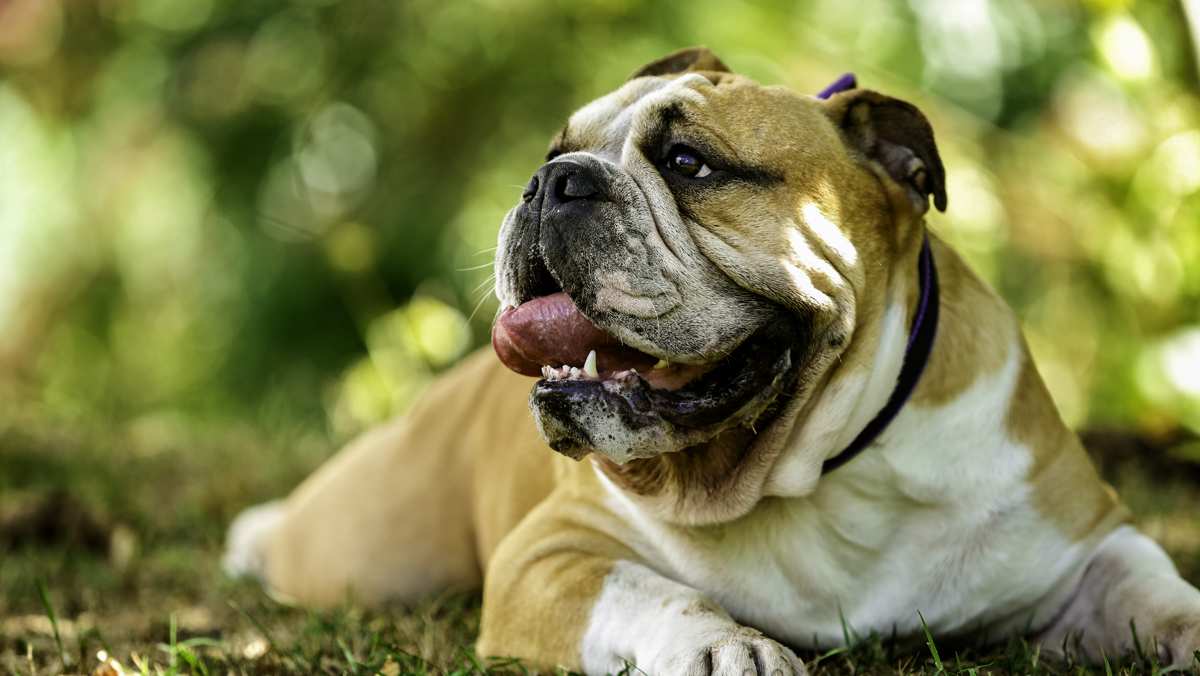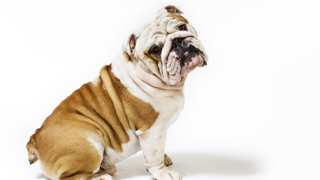British Bulldog
English Bulldog
The bulldog is one of the most recognizable dog breeds due to its unique appearance and its frequent use as a mascot for many sports and businesses. The breed today is considered a gentle family dog with a lazy attitude, which is nearly opposite of the breed's ancestors which were bred solely for a gruesome sport called bull baiting.
Today's bulldog is a child loving companion dog with a gentle nature. Their high pain tolerance and lazy attitude makes them ideal dogs for young rambunctious children whose curiosity and rough housing may intimidate or upset other dogs breeds.
Long ago, Bulldogs were bred to be fighting dogs. Typically, that is no longer the case. These dogs are best as companion animals for people who spend a lot of time away from home or who are not overly active. In some ways, Bulldogs are not bad for people wanting their first dogs. In other ways, this breed is best for people who know to have a great amount of patience and other significant resources to attend common Bulldog problems. Because there are some places with Bulldog bans as well as the growing trend of severe health problems, there are many companies that offer Bulldog insurance. You should consider this and other Bulldogs facts if you want to adopt one of these dogs.
Here are some Bulldog pros and cons:
PROS
- Lovable
- Very sweet
- Highly tolerant
- Doesn't bark much
- Low grooming needs
- Good with mature kids
- Easy going temperament
- Few exercise requirements
- Doesn't mind being left alone
CONS
- Lazy
- Stubborn
- Over eats
- Sheds a lot
- Prone to obesity
- Drools constantly
- Very sensitive to cold
- Highly intolerant of heat
- Expensive in many ways
- May be very bad with cats
- Long list of severe health problems
- Noisy — as in snoring, gassy and snorting
- Lots of ill-informed, disreputable breeders
Purebred
8 - 12 yrs.
13 - 15 in.
53 - 55 lbs
OverallFamily FriendlyChild FriendlyPet FriendlyStranger Friendly
Easy to GroomEnergy LevelExercise NeedsHealthShedding Amount
Barks / HowlsEasy to TrainGuard DogPlayfulnessWatch Dog
Apartment DogCan be AloneGood for Busy OwnersGood for New OwnersIntelligence
Bulldog Breed Description
The bulldog is an extremely thick dog. They have a heavily muscled body, yet are no taller than 15 inches from ground to shoulder. Their body shape and size is a direct result of centuries of careful breeding for bull baiting as dogs which were heavier and lower to the ground were more difficult to be flipped over by the bull's horns. This makes today's bulldog a very stocky and heavy dog.
Today's bulldog is a loving sweet natured dog, with a face that only a mother could love. The breed gets along with everyone and will let strangers step over them without concern. Despite the breeds fierce history, today's bulldog is not a fighter. Bulldogs are excellent with children. The breed will put up with a lot from bored kids and will generally walk away before getting frustrated by children.
The bulldog requires very little maintenance. They are a very low activity dog breed and can meet their exercise needs with a short walk or playtime in the yard. Their coat will need to be brushed once per week to keep it clean, but they will need the wrinkles on their face wiped with a damp cloth every day to prevent dirt and bacteria from accumulating in their skin.
It is thought that Bulldogs were first seen in the 16th century. They were produced to fight bulls, bears and other fierce beasts for highly popular gambling events called "bull baiting." Although the large game animals were tethered or attacked by entire packs, many dogs were gored, crushed and killed. All levels of English society partook in this pastime; there was much money and fame to be had for the person who produced the biggest, hardest and strongest dogs. Prior to being called "bull dogges," they were known by a number of names: Bear Dog, Bolddogge, Bondogge and Butchers Bull were popular ones. The scientific term, Canis Pugnax, was applied in 1666.
The Cruelty to Animals Act of 1835 put an end to public bull baiting and similar bloodsport. It was a watershed moment that apparently jump-started a Bulldog evolution. The shorter muzzles, lesser endurance and sweeter temperaments of today's Bulldogs was probably the result of the 1835 law. It was not too many decades later when, in 1878, The Bulldog Club (England) was founded. Now the oldest single breed club in the world, it was formed at the Blue Post, a pub on Oxford Street in London. To this day, the Club helps to maintain English Bulldog ancestry and hosts a championship show every March.
In 1890, the American Bulldog Club was established in New York by English immigrants who took their Bulldogs with them to the "new world." This club was incorporated under New York State laws in 1904 and was one of the first breed clubs to join the American Kennel Club. In 1922, the U.S. Marines formally adopted the English Bulldog as the corps' mascot. The first formally enlisted Bulldog, Pvt. Jiggs, was inducted at a ceremony at the Marine base in Quantico, Virginia — the same place where, in 1927, his death was mourned after having reached the rank of Sergeant Major in 1924.
Bulldogs may look ferocious in logos, cartoons, and the occasional news story, but there are fewer gentle dogs than this formerly bull-fighting breed.
The broad, boxy and heavy body is low to the ground, and the dog's massive, square-shaped, short-nosed head will have lots of wrinkles. Bulldog jaws have an underbite, and it is not uncommon for the tongue to hang out too. You may have heard a lot about Bulldogs' eyes and that sideways stare; it is too cute! The short, stubby legs are very strong and end in those massive Bulldog paws. Those legs are often depicted as being bowed, and they may even look that way in person, but the legs are straight. Bulldog tails are typically docked; if it isn't, it will be kinked or just hang down.
The coat is loose and wrinkly with short, smooth hair that should not shed much unless there is a dietary or other problem.
The images below represent the coat colors and patterns associated with Bulldogs.
Fallow
Fawn, Brindle, and White
Red and White
Red Brindle
Red, Brindle, and White
While it's generally accepted that there are four basic types of Bulldogs, some people also include miniatures, regional breeds and exotic Bulldogs from elsewhere in the world. The four primary variations, however, are English Bulldog, French Bulldog, American Bulldog and Olde English Bulldogge. In the UK, the English Bulldog is called just a Bulldog and is very flat-faced. The French Bulldog is the smallest Bulldog breed. The American Bulldog is the biggest bulldog breed. The Olde English Bulldog is actually a rare American "variety" that is meant to be much more like the original bulldog: taller, leaner and with a smaller head.
One of the regional Bulldogs is the Alano Español. This breed is native to Spain and has some resemblance to the Presa Canario. Some of the other recent American varieties, which established breed clubs state are basically Bulldogs but which some breeders insist will one day be dog breeds unto themselves, are the XXL Bulldog and the Dwarf Bulldogs. There are a lot of unrecognized, informal names which you might hear too: mini Bulldogs, pocket Bullies, etc.
There are also some extinct varieties, some of which are said by some people to have been breeds: The Bullenbeisser (aka the German Bulldog), the Old English Bulldog (which was the original bull baiting dog and is the model for the Olde English Bulldogge in the USA), and the Toy Bulldog (which became extinct in the early 20th century).
The typical English Bulldog temperament is a little goofy, a little headstrong, a little lazy and a little sloppy. They are far more gentle than their ancestors that were used in death matches against bulls and bears. They can be aggressive around other male dogs or if you try to take away their food. For the most part, they prefer to stay cool dry and asleep. They don't get upset if you're away for long or frequent periods of time, and they don't get anxious if they don't exercise daily. (They just get fat!)
They tend to not get excited around noisy children or most non-canine pets. They are highly sociable dogs who enjoy making new friends and just hanging out. The Bulldog character, however, includes a high tolerance for pain that is good and bad: good when children want to roughhouse, and bad when it comes to pain that can indicate health concerns.
When it comes to training, be prepared to be patient and have a lot of snacks on hand. This may be when one of the most annoying English bulldog traits is on display: stubbornness.
Owning a Bulldog may seem simple enough judging from all the wonderfully fun photos that Bulldog owners post: Bulldogs with babies, with cats, rabbits, other dogs and so much more. What you should understand is that there is a real story happening between those photos, and that story often involves cleaning wrinkles, allergic reactions and lots of flatulence.
On one hand, Bulldogs tend to not bark much, are usually friendly with strangers, and tend to not chase other animals much, if at all. On the other hand, it doesn't take much to give them gas.
Although they have short hair and don't typically shed much, you will find out quickly enough if you are allergic to Bulldogs. The secret is in their wrinkles, and as they have a lot of them on their face, and the dogs drool a lot, that saliva can prompt an allergic reaction. That drool will get on floors, furniture, and clothes.
The health profile of Bulldogs has deteriorated rapidly over the past few decades. Veterinarians have published articles about this decline. Beloved dog whisperer Cesar Millan has asked, "Have we overbred Bulldogs?" Crufts and other dog shows have even refused entry to Bulldogs due to health issues. If you are planning on adopting a Bulldog, you should consider this breed very carefully as well as make sure you find a reputable breeder who will provide all the health tests and vet checks.
Here is a list of the many Bulldog problems:
- Bloat
- Cancer
- Deafness
- Dystocia
- Cataracts
- Cystinuria
- Cherry eye
- Cleft Palate
- Spina Bifida
- Skin allergies
- Head tremors
- Hip Dysplasia
- Heart disease
- Corneal ulcers
- Hydrocephalus
- Hemivertebrae
- Cryptorchidism
- Kidney disease
- Ectopic Ureters
- Hypothyroidism
- Urate Urolithiasis
- Genetic Dwarfism
- Demodectic mange
- Eyelid abnormalities
- Hypoplastic Trachea
Bulldogs have an average lifespan of 8 to 12 years.
Below are potential health concerns associated with Bulldogs.
Entropion
Hip dysplasia
Patellar luxation
Dry eye
Reverse sneezing
Demodectic mange
Cherry eye
Brachycephalic Airway Syndrome
Head shakes
When it comes to the ugly Bulldog, you should know that "ugly" is a pet word for "cute" and that even an ugly English Bulldog is hugely adorable. While they may be big, unwieldy and occasionally impatient, these dogs have a legendary high tolerance for screaming, curious and playful children. In the UK, nanny Bulldogs are well-known despite the dangerous dog bans they may have.
You may be looking to adopt a Bulldog from overseas or far away or want to take your dog when you move (or travel). If so, you should know that English Bulldog air travel rules may be different than for other breeds. Be sure to look up the rules and confirm the airlines' guidelines on Bulldogs before you book a flight.







